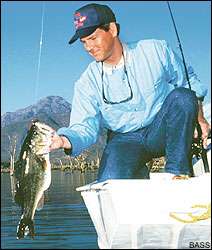
Veteran Missouri fishing guide Robert Robbins can drop a curly-tailed grub on a bass' head 60 feet deep. If you think this is a no-brainer, given the resolution of today's liquid crystal graphs (LCG), think again.
A transducer with a 24 degree cone angle covers a 25-foot-diameter circle at a depth of 60 feet. That means your bait and a bass may be 25 feet apart, yet appear to be right next to each other on the LCG display. You believe the bass is eyeballing the bait, but the fish doesn't know it exists.
Robbins, who competes in the BASS Central Open Division, excels at vertical presentations. When bass suspend deep on Table Rock, Bull Shoals, Ouachita and other clear water reservoirs, he usually does well in any tournament he enters.
Robbins' advanced sonar tactics are so precise they amount to deep sight fishing. He knows when his grub is close to bass, and often sees bass move to nab his offering.
The heart of Robbins' advanced sonar fishing method is a transducer mounted to the outboard with a homemade bracket. It connects to the leading edge of the outboard's lower unit just above the cavitation plate. The transducer lifts out of the water when the boat is on plane.
A Humminbird SS1-6 Transducer Switch feeds the outboard's transducer to the Humminbird Legend fishfinder mounted on the front deck of Robbins' bass boat. The Universal Transducer on his electric motor also connects to the transducer switch.
"If I'm fishing less than 35 feet deep, I go with the electric motor's transducer," says Robbins. "The cone diameter is only about 15 feet at that depth, and it narrows toward the surface. I switch to the rear transducer when I fish deeper than 35 feet."
The rear transducer (shooting straight down) puts the forward portion of the cone under the middle of Robbins' 21-foot boat at 60 feet. He trims the outboard in to move the leading half of the cone directly beneath his bow fishing deck. When fishing less than 60 feet deep, he trims the outboard out until the leading edge of the cone lies directly under him.
As Robbins inches his boat forward with the electric motor, bass first show up in the front half of the cone. When he drops a grub straight down, it falls into the forward portion of the cone, where it is close enough to get the bass' attention. (See Diagram A.)
To further refine the cone's direction, Robbins angles the transducer slightly to the starboard (driver's) side of the boat. He always fishes off the starboard side to put his bait in the center of the cone.
Sonar seasons
"I start looking for suspended bass soon after they finish spawning," says Robbins. "I catch them right through the summer, often around 40 feet deep. Fishing gets better in the fall, with December being especially good. Bass are usually down around 60 feet then."
Deep, vertical fishing produces spotted, largemouth and smallmouth bass for Robbins. He claims smallmouth suspend higher than the other species.
All bass respond well to a Bass Pro Shops XPS 4-inch single tail grub in smoke or milk and pepper. Robbins rigs the grub on a 5/16-ounce ball head jig. A Bass Pro Shops Extreme 7-foot medium action spinning rod, a Johnny Morris reel, and 6-pound-test XPS fluorocarbon line serve up the grub. The thin line lets the jig get deep fast. The long rod ensures solid hook ups.
"I usually move around until I see a bass," says Robbins. "It may be 40 to 60 feet deep above 100 feet of water. I drop the grub to the bass and just shake it in place. Most people overwork a grub. There is always enough wave action and boat movement to give the tail action."
Strikes are usually soft. You may not feel the bite, but rather, the rod loading with the weight of the bass. Because the water is clear, bass frequently swim up and take the grub as it falls.
"When bass swim up for the bait, I see a line on the graph," says Robbins. "Most people expect to see an arch. That's wrong. If I see bass moving up or down on the graph, I follow them with the grub. I can see it, too."
Sonar settings
Many depthfinders perform so well in automatic mode that they need little or no adjusting to deliver reasonably good images for deep, vertical fishing. Robbins dotes on the simplicity of his Humminbird Legend. Even so, he manually adjusts the unit so it delivers optimum images of suspended bass. He recommends the following:
Turn the gain all the way up.
Set the chart speed on the 5 (medium) setting.
Adjust for a light gray line.
Zoom in to eliminate the upper level and surface clutter.
Transom transduce
"You don't have to make a transducer bracket for the outboard as I did," says Robbins. "A transducer mounted to the boat's transom also works well. I know several guys who do this. They change the angle of the transducer by reaching into the water and adjusting it by hand."





